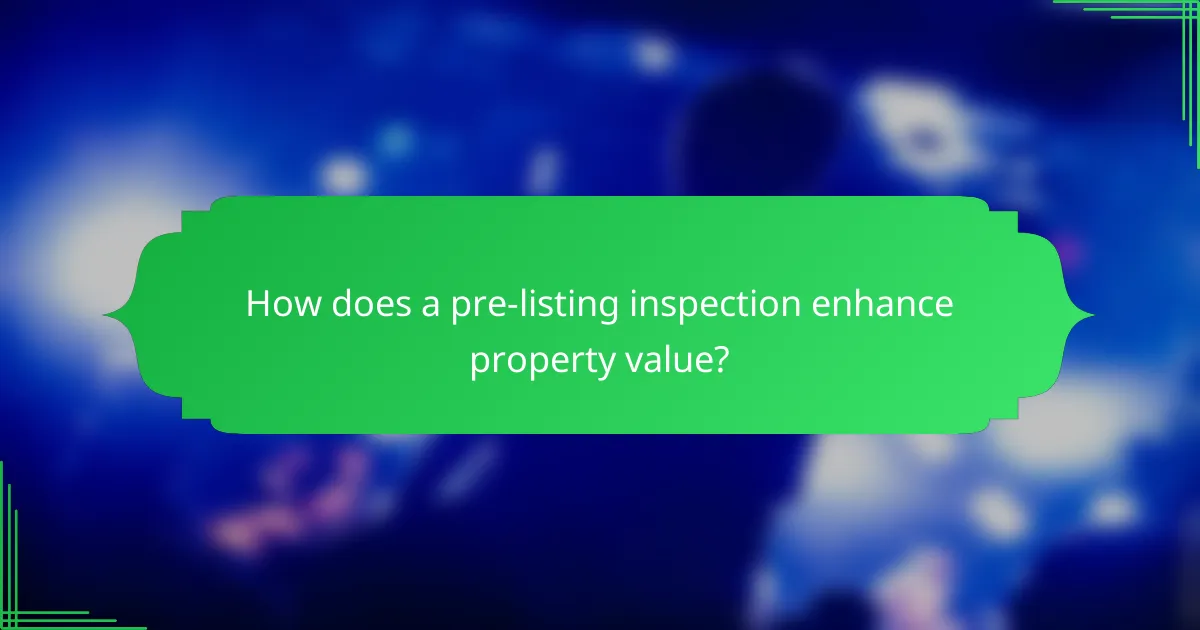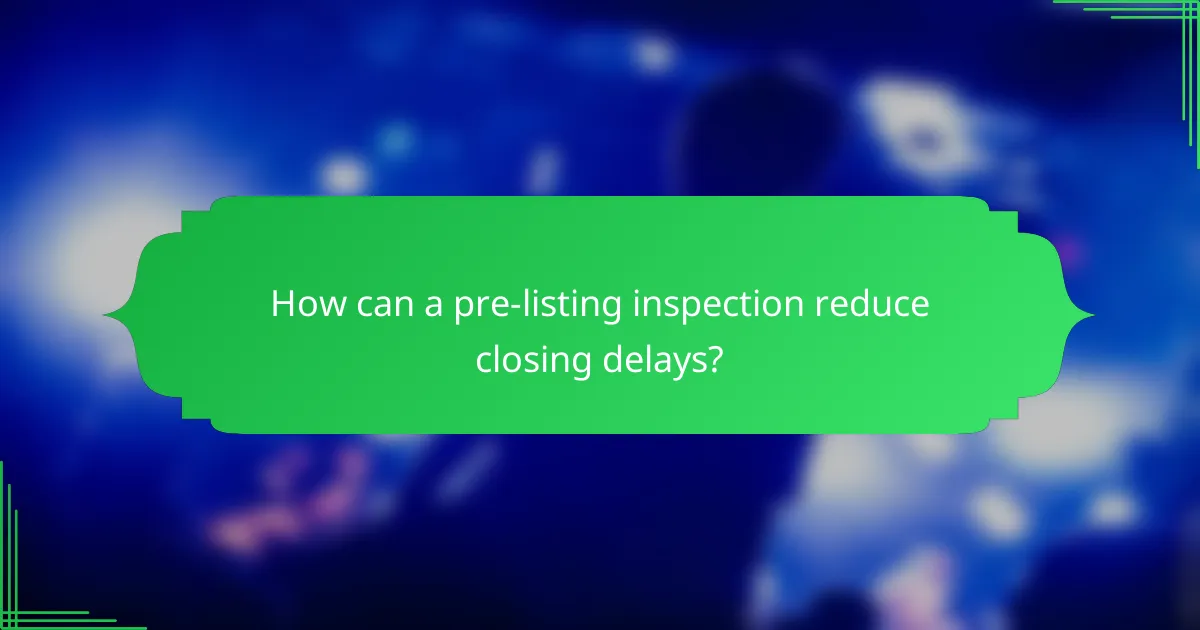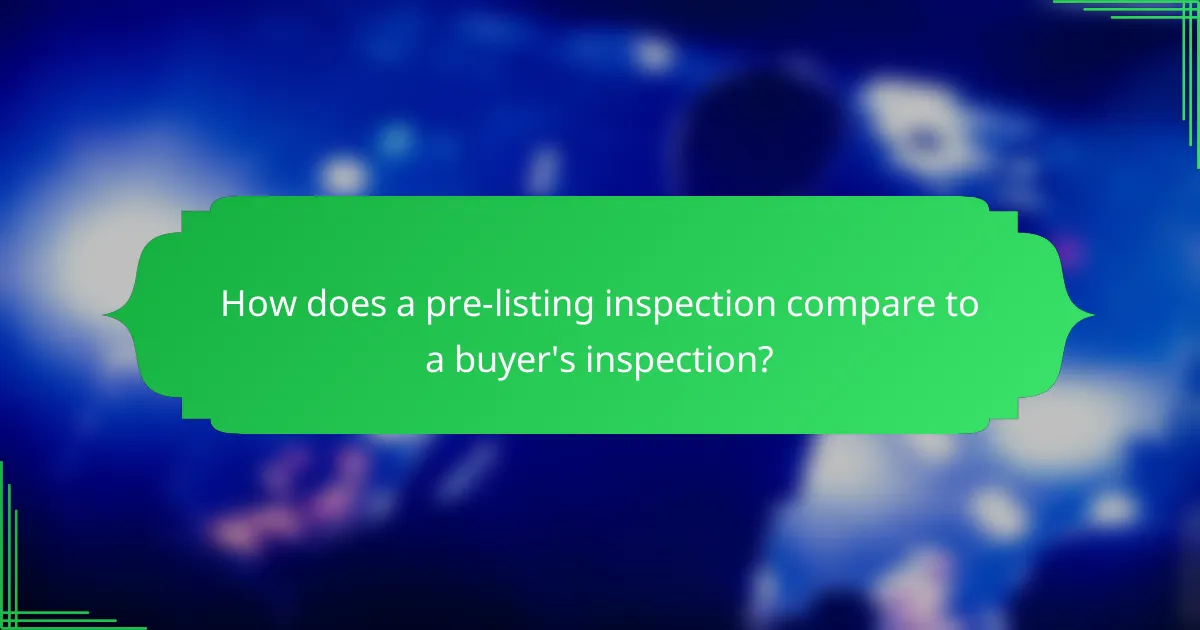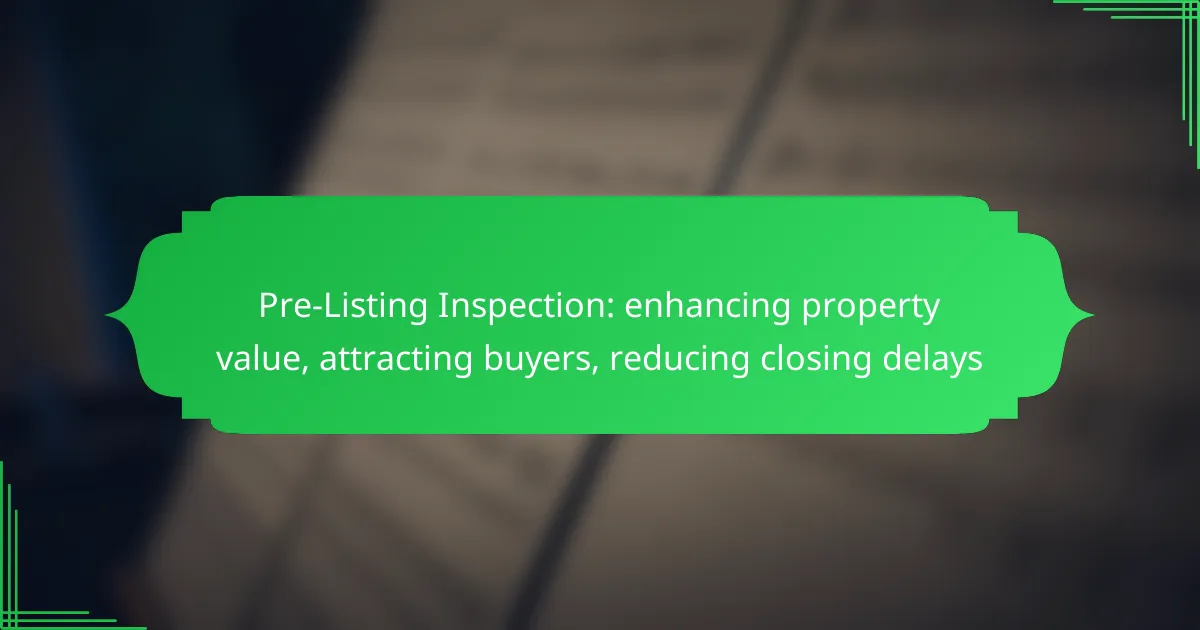A pre-listing inspection is a strategic tool for sellers that enhances property value by uncovering issues before they deter potential buyers. By addressing concerns upfront, sellers can attract more interest, streamline the selling process, and reduce closing delays, ultimately leading to quicker sales and potentially higher offers.

How does a pre-listing inspection enhance property value?
A pre-listing inspection enhances property value by identifying issues before they become deal-breakers, improving buyer confidence, and allowing for a more strategic pricing approach. This proactive measure can lead to quicker sales and potentially higher offers, making it a valuable step for sellers.
Identifies necessary repairs
A pre-listing inspection uncovers necessary repairs that may not be visible during a casual walkthrough. By addressing these issues upfront, sellers can avoid surprises during buyer inspections, which often lead to negotiations or price reductions. Common repairs might include fixing plumbing leaks, electrical issues, or roof damage.
Consider creating a checklist of potential problem areas to discuss with your inspector, such as HVAC systems, foundation integrity, and pest infestations. This preparation can help you prioritize repairs based on their impact on saleability and cost-effectiveness.
Improves buyer confidence
When sellers provide a pre-listing inspection report, it signals transparency and builds trust with potential buyers. Buyers are more likely to feel secure in their investment when they know the property’s condition has been professionally evaluated. This confidence can lead to quicker offers and fewer contingencies.
To further enhance buyer confidence, consider offering a home warranty along with the inspection report. This additional assurance can make your property more attractive compared to others on the market.
Optimizes pricing strategy
A pre-listing inspection allows sellers to set a more accurate asking price based on the property’s condition. By understanding the necessary repairs and overall state of the home, sellers can avoid overpricing, which can deter buyers, or underpricing, which can lead to financial loss.
Research comparable properties in your area to gauge the right price range. Adjust your pricing strategy based on the findings of the inspection, ensuring that it reflects both the home’s current condition and the local market trends.

What are the benefits of a pre-listing inspection for attracting buyers?
A pre-listing inspection offers several advantages for attracting buyers, including a clearer understanding of the property’s condition and a reduction in potential buyer concerns. By addressing issues upfront, sellers can enhance their property’s appeal and streamline the selling process.
Highlights property condition
A pre-listing inspection provides a detailed report on the property’s condition, allowing sellers to showcase its strengths and address any weaknesses. This transparency can instill confidence in potential buyers, as they can see that the seller is proactive and honest about the property’s state.
For example, if a home has recently updated plumbing or a new roof, these positive aspects can be highlighted in marketing materials, making the property more attractive. Conversely, identifying and fixing minor issues before listing can prevent them from becoming red flags during buyer inspections.
Reduces perceived risk
By conducting a pre-listing inspection, sellers can significantly lower the perceived risk for buyers. When buyers are aware of any existing issues and see that they have been addressed, they are more likely to feel secure in their investment.
This can lead to fewer negotiations and disputes over repairs after an offer is made. Buyers are often willing to pay a premium for homes that have been inspected and certified as move-in ready, which can ultimately lead to a higher sale price.
Facilitates quicker sales
A pre-listing inspection can expedite the sales process by eliminating surprises that could delay closing. When a property is inspected beforehand, sellers can make necessary repairs, ensuring that the home meets buyer expectations from the start.
Additionally, properties that come with a clean inspection report often attract more interest, leading to quicker offers. In competitive markets, this can mean the difference between a property sitting on the market for weeks versus receiving multiple offers within days.

How can a pre-listing inspection reduce closing delays?
A pre-listing inspection can significantly reduce closing delays by identifying and addressing potential issues before the property is listed. This proactive approach allows sellers to make necessary repairs and provides buyers with confidence, leading to smoother transactions.
Addresses issues before listing
Conducting a pre-listing inspection helps sellers identify problems that could derail a sale later on. Common issues include plumbing leaks, electrical faults, or structural concerns. By addressing these issues upfront, sellers can avoid last-minute negotiations or buyer walkaways.
For example, if a roof is found to be in poor condition during the inspection, the seller can either repair it or adjust the listing price accordingly. This transparency can prevent surprises that might arise during a buyer’s inspection.
Streamlines negotiation process
A pre-listing inspection can streamline negotiations by providing both parties with a clear understanding of the property’s condition. When buyers are aware of existing issues beforehand, they are less likely to request extensive repairs or price reductions during negotiations.
This clarity can lead to quicker agreements and fewer back-and-forth discussions, ultimately speeding up the closing process. Sellers can present the inspection report to buyers, which can help justify the asking price and build trust.
Enhances transparency
Transparency is crucial in real estate transactions, and a pre-listing inspection fosters this by openly sharing the property’s condition. When sellers provide inspection reports, buyers feel more secure in their decision-making process.
This openness can enhance the property’s appeal, as buyers appreciate knowing what they are investing in. It can also reduce the likelihood of disputes arising after the sale, as both parties have agreed on the property’s condition from the start.

What are the costs associated with a pre-listing inspection?
The costs associated with a pre-listing inspection can vary, but they generally include inspection fees, potential repair costs, and the impact on the overall sale price. Understanding these expenses helps sellers make informed decisions that can enhance property value and streamline the selling process.
Inspection fees
Inspection fees typically range from a few hundred to over a thousand dollars, depending on the property’s size and location. For instance, a standard home inspection might cost between $300 and $600 in the United States, while larger properties or specialized inspections (like for mold or pests) can increase this amount.
It’s essential to choose a qualified inspector who adheres to local standards. Investing in a reputable inspector can uncover issues that, if left unaddressed, could lead to larger expenses later in the selling process.
Potential repair costs
After the inspection, sellers may face repair costs that can vary widely based on the findings. Common repairs include roof replacements, plumbing issues, or electrical upgrades, which can range from a few hundred to several thousand dollars. For example, fixing a leaky roof might cost between $1,000 and $5,000, depending on the extent of the damage.
Addressing these repairs before listing can not only improve the property’s appeal but also prevent negotiations from stalling due to buyer concerns. Sellers should prioritize repairs that significantly impact safety and functionality.
Impact on overall sale price
A pre-listing inspection can positively influence the overall sale price by providing transparency and building buyer confidence. Homes that have been inspected and repaired often sell for higher prices, as buyers are less likely to request concessions or price reductions due to undisclosed issues.
In some markets, properties with a clean inspection report can command a premium, sometimes achieving sale prices that are 5-10% higher than similar homes without such documentation. Sellers should consider the potential return on investment when weighing the costs of inspection and repairs against the expected increase in sale price.

What should sellers look for in a pre-listing inspector?
Sellers should prioritize finding a qualified pre-listing inspector who can identify issues that may affect property value and buyer interest. A thorough inspection can enhance the property’s appeal and streamline the selling process.
Qualifications and certifications
When selecting a pre-listing inspector, verify their qualifications and certifications. Look for inspectors who are certified by recognized organizations, such as the International Association of Certified Home Inspectors (InterNACHI) or the American Society of Home Inspectors (ASHI).
Additionally, ensure they have completed relevant training and adhere to local regulations. This guarantees that the inspector is knowledgeable about the standards and practices necessary for a comprehensive evaluation.
Experience with similar properties
Choose an inspector who has experience with properties similar to yours in size, age, and type. This familiarity allows them to identify common issues that may arise in your specific property category.
For example, if you own a historic home, an inspector with experience in older properties will know what to look for regarding structural integrity and potential code violations. This targeted expertise can lead to more accurate assessments and recommendations.
Sample inspection reports
Request sample inspection reports from potential inspectors to evaluate their thoroughness and clarity. A good report should clearly outline findings, include photographs, and provide actionable recommendations.
Reviewing these samples will help you gauge how well the inspector communicates issues and whether their reporting style aligns with your expectations. Look for reports that are easy to understand and highlight both major and minor concerns effectively.

How does a pre-listing inspection compare to a buyer’s inspection?
A pre-listing inspection is conducted by the seller before listing the property, while a buyer’s inspection occurs after an offer is made. The main difference lies in the timing and purpose: the pre-listing inspection helps sellers identify issues to address, whereas the buyer’s inspection aims to uncover potential problems for the buyer’s consideration.
Timing of inspections
Pre-listing inspections are performed before the property is officially on the market, allowing sellers to make necessary repairs and present a more appealing home to potential buyers. In contrast, buyer’s inspections typically take place after an offer is accepted, which can lead to delays if issues arise.
By scheduling a pre-listing inspection, sellers can streamline the selling process, reducing the likelihood of last-minute negotiations or extended closing timelines caused by unexpected findings during a buyer’s inspection.
Focus on seller’s perspective
The primary focus of a pre-listing inspection is to empower sellers by providing them with a clear understanding of their property’s condition. This knowledge enables sellers to proactively address repairs, enhancing the property’s value and attractiveness to buyers.
In contrast, a buyer’s inspection is centered around the buyer’s interests, often leading to negotiations based on the inspection findings. Sellers who conduct pre-listing inspections can mitigate risks and foster a smoother transaction by being transparent about the property’s condition.
Cost implications
Investing in a pre-listing inspection typically costs a few hundred dollars, depending on the property’s size and location. This upfront expense can be offset by the potential for a higher selling price and quicker sale, as buyers may feel more confident in a well-maintained property.
On the other hand, a buyer’s inspection may lead to unexpected costs for sellers if issues are discovered that require repairs or price reductions. By addressing problems beforehand, sellers can avoid these financial surprises and negotiate from a position of strength.
